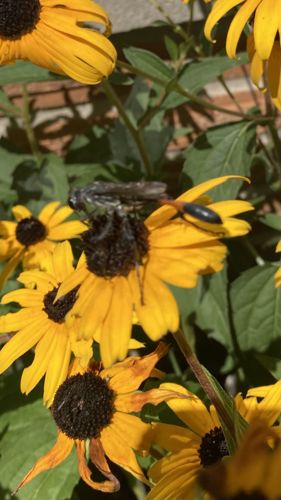Two-spotted Scoliid Wasp or Blue-winged Scoliid Wasp
Scientific Name: Scolia dubia
Order & Family: Order: Hymenoptera, Family: Scoliidae
Size: Typically around 1.5 to 2.5 cm (0.6 to 1 inch) in length.

Natural Habitat
Adult Scoliid wasps are commonly found in gardens, fields, meadows, and other areas where their host beetle larvae are present and where flowering plants provide nectar sources. They are often seen flying low over lawns or digging in the soil where beetle grubs reside.
Diet & Feeding
Adult Scoliid wasps primarily feed on nectar and pollen from a variety of flowers. The larvae are parasitic, feeding on the grubs of Scarab beetles (e.g., Japanese beetles, May beetles).
Behavior Patterns
This specific Scoliid wasp species, *Scolia dubia*, is known for its parasitic behavior towards beetle larvae, particularly scarab grubs. Females dig into the ground to find their host, sting and paralyze it, and then lay a single egg on the grub. The wasp larva then consumes the beetle larva. Adults are solitary and frequently visit flowers for nectar, especially those with open, accessible blooms like the Black-eyed Susans seen in the image. They are active during warmer months, typically summer and early fall.
Risks & Benefits
Scoliid wasps are generally considered beneficial insects. They are excellent biological control agents for various pest beetle grubs, helping to reduce damage to lawns and garden plants. They are also effective pollinators as adults visit flowers for nectar. While they are wasps and can sting, stings are rare unless they are directly handled or threatened, and their venom is not considered medically significant to humans, usually causing only localized pain.
Identified on: 8/26/2025